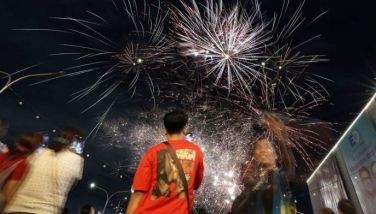Sulpicio used inbound lane
CEBU, Philippines - Amid contradicting claims by the two ship captains on who was really at fault for the tragedy, the captain of a third sea vessel that was in the area during the collision corroborated the account of MV St. Thomas Aquinas’ captain that Sulpicio Express Siete, which was on its way out of Cebu, was on the inbound lane.
The captains of the three ocean vessels appeared yesterday before the Special Board of Marine Inquiry (SBMI), which was able to gather a “clearer view†of what really happened on the night of August 16 or Friday last week wherein 79 people died and 41 remain missing.
During the inquiry, the captains of 2GO’s MV St. Thomas Aquinas, the passenger vessel coming from Mindanao, and Span Asia’s Sulpicio Express Siete, the cargo ship that just left Cebu, reiterated the statements contained in their marine protests: 2GO blamed the outgoing Sulpicio for using the inbound lane, while Sulpicio denied this and claimed it was 2GO that suddenly changed course.
But the captain of Trans Asia Nine, Captain Galipher Ian Faller, explained to the SBMI yesterday that since Sulpicio Express was on the inbound lane, he decided to overtake on its starboard side (right).
Like Sulpicio Express, Trans Asia had also just left the Cebu pier. It was on its way to Cagayan de Oro City. Faller later admitted that most captains of outgoing vessels prefer to stay in the inbound lane because the outbound lane is shallow.
Tran Asia Nine was included in the investigation after allegedly failing to respond to the distress call even while they were still in the area, violating protocol.
But Faller explained that they were still in shallow waters and risked running aground if they go back. He said they were also 5.6 nautical miles away from the two ships, which would take a lot of time to respond.
Narrating what transpired before the collision, Faller said it was Sulpicio Express that asked them to shift to Channel 12. Director Arnie Santiago of the Maritime Industry Authority explained that communication of ships, as indicated in their rules, should be in Channel 16.
The captain confirmed that there was a lot of interference in channel 16. Faller said he communicated with Sulpicio Express Siete to ask where it was headed. The cargo vessel replied with a request to change to channel 12, said Faller.
After they overtook the cargo vessel, Faller said they passed by MV Saint Thomas Aquinas and said they noticed the green signal on the passenger ship, and not red as claimed by Sulpicio.
Sulpicio Express Siete Captain Rolito Gilo, who was emotional when issuing his statement during yesterday’s inquiry, said it was MV Saint Thomas Aquinas that suddenly changed its gear at only 0.4 nautical miles.
He said he thought the passenger vessel would turn to its starboard or its right side since it was showing a red light.
Gilo also said he was using the outbound lane and was going straight when suddenly the passenger vessel turned. Because the passenger ship’s change of direction was quick, Gilo said he was not able to avoid it.
He said there was no more chance to do anything because it was only a fraction of seconds. Gilo added that he shouted to stop engine and then sent the distress call.
Before the collision, Gilo said another vessel, Trans Asia Nine, was behind them and asked for permission to overtake which he allowed.
For his part, MV Saint Thomas Aquinas Captain Reynan Bermejo narrated that he noticed in the radar that another ship was also on the inland lane he was using.
Bermejo said he tried to contact the other ship through channel 16 but there was no answer. His ship was travelling at around 15 knots and was a mile away from the Sulpicio Express.
But minutes before the collision and with the other ship not responding, he said it was already too late to slow down, explaining that it takes around eight minutes for them to stop the propeller of the ship completely.
“Dahil sa Sulpicio, hindi na ako naka-reduce (speed).â€
Four minutes before the collision, Bermejo said it was only then that they saw the red light from Sulpicio Express which led him to immediately turn to hard port or left side.
The red light is a sign for a ship to turn right while green signals left.
Upon shifting to the port side, Bermejo said he then attempted to turn right to avoid the collision.
Sulpicio Express Siete also shifted its gear but also to its right which consequently led to the collision, said Bermejo.
Today, the shipping companies are set to present other crew members to the SBMI.
The SBMI also summoned Oceanjet, another passenger vessel that was reportedly in the area before the accident.
Yesterday, PCG Cebu Commander Weniel Azcuna was first called in for questioning. He stated that they immediately responded to the distress call of MV Saint Thomas Aquinas after receiving it around 9:03 in the evening.
The SBMI also took in some statements of survivors of the MV Saint Thomas Aquinas.
Commander Gilbert Rueras confirmed that all the proceedings will be in Cebu, rather than in Manila, and will be done in two weeks as ordered by President Benigno Aquino III.
Commander Gilbert Rueras of the Philippine Coast Guard (PCG) and the chairman of the board stressed that the captains were all considered resource persons rather than witnesses since the proceedings were inquisitional rather than adversarial./JPM (FREEMAN)
- Latest























